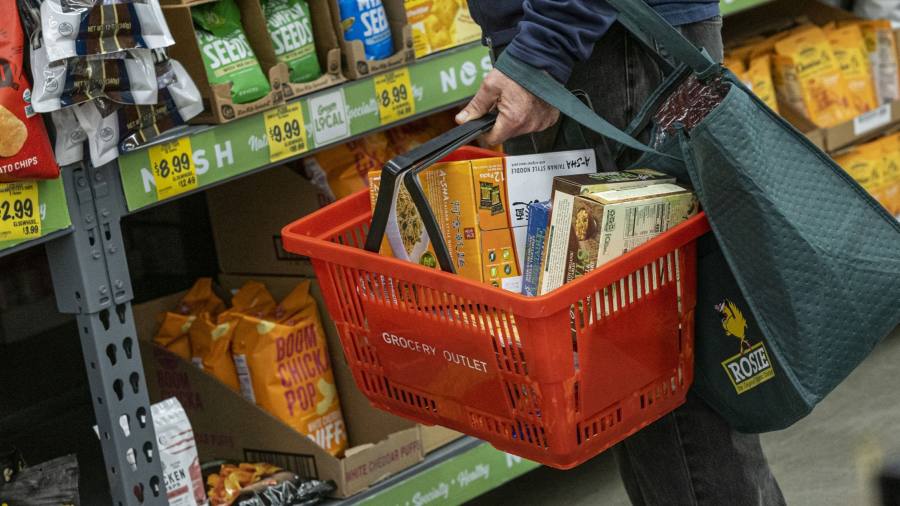[ad_1]
Wall Street stocks bounced back from a sharp early sell-off on Thursday that was triggered by US inflation data that came in hotter than expected.
The broad S&P 500 ended the day up 2.6 per cent, having dropped as much as 2.4 per cent earlier in the session. The Nasdaq Composite rose 2.2 per cent, recovering from a decline of about 3.2 per cent.
The latest bout of volatility in equity markets came after the closely watched US consumer price index reading for September landed at 8.2 per cent, marking a slight easing in the annual rate of inflation from 8.3 per cent in August, but above economists’ forecast of 8.1 per cent.
The core CPI reading, which excludes food and energy prices, came in at 6.6 per cent, above expectations of 6.5 per cent and the previous month’s reading of 6.3 per cent.
The explanations for the dramatic recovery in stocks were varied. Some investors argued that the sell-off in equities in recent weeks had been overdone and traders were capitulating on Thursday. The CPI data also tend to be backward-looking and some investors suggested that newer data, particularly on rental costs, show prices falling.
“You had a whole reversal and it looks like a capitulation. The sell-off was overdone,” said Andy Brenner, head of international fixed income at NatAlliance, who said he had heard of some investors covering their short positions, which may have contributed to the reversal in stocks.
“The reasons the CPI number was bad were very backward looking. [Real estate broker] Redfin numbers show that rents are going down, so there is a real discrepancy between the CPI data and forward-looking numbers,” Brenner said.
The dollar rose immediately after the CPI report, but later reversed its gains to trade down 0.7 per cent against a basket of six peers. The strength of the greenback had helped send Japan’s yen to its lowest level since 1990 on Thursday of ¥147.67.
US government bonds were hit by a bout of selling after the CPI data release, pushing yields higher, but this eased later in the session, with the 10-year US yield up 0.06 percentage points to 3.96 per cent. The two-year yield, which is more sensitive to interest rate expectations, added 0.19 percentage points to 4.48 per cent. Bond yields rise as their prices fall.
Market participants have scrutinised reports on price growth and the state of employment in the US economy for signs of how vigorously the Federal Reserve and its international peers will tighten monetary policy. Concerns have intensified this year that the series of rate rises intended to curb inflation will trigger a protracted slowdown.
Futures markets on Thursday signalled that investors had cranked up their expectations of how far the US central bank will lift borrowing costs, now anticipating a rate of almost 4.9 per cent by May 2023 — up from projections a day earlier of just under 4.65 per cent.
The Fed has already raised borrowing costs by 0.75 percentage points at each of its past three meetings, taking its benchmark interest rate to a range of 3 to 3.25 per cent. Markets are pricing in expectations of a fourth consecutive increase of similar magnitude.
The Fed said in minutes from its September monetary policy meeting, released on Wednesday, that the central bank was concerned about doing “too little” to stamp out soaring inflation.
“Rising prices, combined with last month’s stronger than expected jobs report, all but guarantee the Fed will enact its fourth 0.75 percentage point rate hike when officials next meet in November,” said Richard Flynn, managing director of Charles Schwab UK.
Equity and bond markets have come under acute pressure this year, pummelled by rising interest rates and the prospect of monetary policy screws being twisted further.
Higher borrowing costs have damaged the appeal of more speculative stocks that were winners earlier in the coronavirus pandemic, biting into their projected cash flows, which are typically modelled into the future. The tech-heavy Nasdaq Composite share index has tumbled by about a third this year.
Elsewhere, Europe’s regional Stoxx 600 share index closed 0.8 per cent higher, swinging back from earlier losses. Hong Kong’s Hang Seng closed 1.9 per cent lower.
The pound added 1.9 per cent against the US currency to $1.13, as it emerged that British prime minister Liz Truss was in discussions about a U-turn on the government’s “mini” Budget.
[ad_2]
Image and article originally from www.ft.com. Read the original article here.

